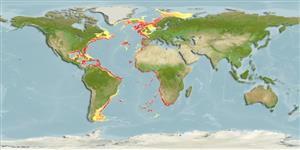Environment: milieu / climate zone / depth range / distribution range
Ökologie
seewasser bathydemersal; tiefenbereich 45 - 1300 m (Ref. 5951), usually 300 - 823 m (Ref. 5951). Deep-water
Western Atlantic: coasts of Canada and United States, Gulf of Mexico, Caribbean, and the coast of South America to Rio de Janeiro, Brazil; in the east, from the Gulf of Guinea to Angola.
Size / Gewicht / Alter
Maturity: Lm ? range ? - ? cm
Max length : 39.4 cm TL Männchen/unbestimmt; (Ref. 5951); common length : 14.5 cm SL Männchen/unbestimmt; (Ref. 4490)
Rückenflossenstacheln (insgesamt): 0; Rückenflossenweichstrahlen (insgesamt): 5-7; Afterflossenstacheln 0; Afterflossenweichstrahlen: 4; Wirbelzahl: 18 - 19. Tubercles (its form of scales) have ridges radiating from the apical spine; these ridges heavily edged with spinules, especially the largest tubercles; thus, tubercles appear to be multi-spined. Vertebral count usually 18. Cephalic lateral-line counts: subopercular 4-6, preopercular, 1-3. Tail lateral-line counts 9-13. Usual number of dorsal fin rays 6, pectoral fin rays 14-15; vertebrae 18. Color differences observed between eastern and western Atlantic populations; specimens from Gulf of Guinea often have reticulate markings on the dorsal surface of the body, usually vague (occasionally strong), which are not seen in western Atlantic material. Fins, except dorsal, usually have tubercles on bases of rays. Pectoral fins slender, sturdy relative to most other species; pelvic fins slender (Ref. 40826).
Found on mud or sand-mud bottoms (Ref. 26999). Benthic adults are luminous (Ref. 40826). Feeds chiefly on polychaetes; bottom-living amphipods, bivalve molluscs, brittle stars, starfishes and sea spiders (Ref. 5951).
Life cycle and mating behavior
Geschlechtsreife | Fortpflanzung | Ablaichen | Eier | Fecundity | Larven
Bradbury, M.G., 1999. A review of the fish genus Dibranchus with descriptions of new species and a new genus, Solocisquama (Lophiiformes, Ogcocephalidae). Proc. Calif. Acad. Sci. 51(5):259-310. (Ref. 40826)
IUCN Rote Liste Status (Ref. 130435)
Bedrohung für Menschen
Harmless
Nutzung durch Menschen
Fischereien: kommerziell
Mehr Information
NamenSynonymeMetabolismusRäuberÖkotoxikologieFortpflanzungGeschlechtsreifeAblaichenSpawning aggregationFecundityEierEientwicklung
ReferenzenAquakulturAquakultur ProfilZuchtlinienGenetikElectrophoresesVererbbarkeitKrankheitenVerarbeitungNutrientsMass conversion
PartnerBilderStamps, Coins Misc.LauteCiguateraGeschwindigkeitSchwimmstilKiemenoberflächeOtolithsGehirngrößeSehfähigkeit
Tools
Zusatzinformationen
Download XML
Internet Quellen
Estimates based on models
Preferred temperature (Ref.
123201): 3.2 - 13.9, mean 8.2 °C (based on 646 cells).
Phylogenetic diversity index (Ref.
82804): PD
50 = 0.5001 [Uniqueness, from 0.5 = low to 2.0 = high].
Bayesian length-weight: a=0.01479 (0.00517 - 0.04233), b=2.93 (2.69 - 3.18), in cm total length, based on LWR estimates for this (Sub)family-body shape (Ref.
93245).
Trophic level (Ref.
69278): 3.4 ±0.42 se; based on food items.
Widerstandsfähigkeit (Ref.
120179): niedrig, Verdopplung der Population dauert 4,5 - 14 Jahre. (Preliminary K or Fecundity.).
Fishing Vulnerability (Ref.
59153): Low to moderate vulnerability (29 of 100).
